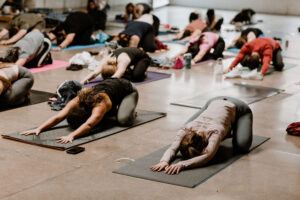Breathing; it seems easy enough, right? It’s automatic, rhythmic, and maintained without much exertion. But before we go on, do you mind if we try a little experiment?
Wherever you are reading this, pause and take a moment to slowly scan your body. Unclench your jaw. Drop your shoulders away from your ears. Shine your chest up towards the ceiling. Draw your bellybutton in towards your spine.
Now, take one deep breath. Did you inhale through your nose, or through your mouth? Try it again, this timing inhaling through your nose and mentally following the breath all the way down to your stomach. Feel your diaphragm expand and your bellybutton press against the waistband of your pants. As you exhale, pull your stomach in towards your ribs and imagine the breath traveling back up through your chest, through your throat, and finally out through your nose.
How did that feel? Pretty great, right? That’s the essence of functional breathing. So, while it’s true that breathing is an automatic process, doing it correctly may actually require attention, intention, and even a bit of relearning. We’re here to help you fine-tune the fundamentals so you can finally tap into the true power of your breath.

Nose, goes!
Human beings are anatomically designed to breathe in and out of our noses. In fact, babies are born knowing only to use their noses for breath. Mouth-breathing is a learned habit, and not the best one if we’re being honest!
Breathing through your nose has an array of benefits, like filtering out debris and toxins and humidifying the oxygen. Think about it: the air you’re inhaling can contain any amount of pollutants from the environment. This is always true; whether you are indoors or outdoors. Scent is just one example, but for most of us, it’s the easiest to recognize because different smells produce clear, visceral and emotional reactions.
Have you ever walked into an elevator, only to be hit by what feels like a dense cloud of a previous passenger’s cologne? You can’t see the person (they’ve already gotten off on their floor) or their cologne hanging in the air. Nevertheless your nose picks up the aerosols and registers two squirts too many of Acqua Di Gio.
Beyond just scent, the oxygen you breathe in is also fully loaded with things like dust, bacteria, mold, pollen, and soil. The scientific name for this is particle pollution or particulate matter (PM); which really just means the mixture of solid and liquid droplets suspended in the air at any given point in time. The small hairs lining the inside of your nose, called cilia, help to catch these pollutants before they move through your windpipe and into your lungs. It’s estimated that the nose catches upwards of 20 billion foreign particles every single day!
When you breathe through your mouth, the air also tends to be much drier. If you are your household’s resident snorer, then you’re certainly no stranger to this. After a night of sleeping with your mouth open, it’s typical to find drool coating your cheeks and an awfully dry throat. Your nose is responsible for adding essential moisture to the oxygen, while regulating the temperature.

Finally, nose-breathing controls the amount of air that comes into your lungs with every inhalation. Your nose, unlike your mouth, allows you to draw in the precise amount of oxygen that your body needs. Unlike mouth-breathing, which tends to lead to quick, shallow breaths, breathing through your nose supports slower, deeper breaths. These deep, belly breaths, much like the one you took in the exercise above, stimulate the lower lungs, improve overall oxygenation, and trigger the parasympathetic receptors that signal a sense of calm.
So, yeah, your nose is kind of a big deal!
Check your posture!
Think back to the last time you contorted your sweaty body into a human pretzel in the middle of your monthly hot yoga class. How did it feel to breathe during the peak of the pose? Pretty challenging, right? The physical demands aside, part of the reason it can feel so difficult to draw in a full breath is because your diaphragm quite literally isn’t able to.
To draw in one, complete, belly breath, your diaphragm needs to be able to expand, contract, ascend, and descend without obstruction. When your spine is bent over or your ribcage is twisted, for example, your diaphragm isn’t able to move to its full capacity. As a result, your breath becomes shallower, much like what happens during nose-breathing.
Posture is a second critical component of breathing. Even beyond your yoga mat, it has the ability to “make or break” the function or dysfunction of your breath. Correct physical alignment supports correct breathing patterns, and those breathing patterns consecutively support your alignment. Without the right posture, your body never has the opportunity to establish a proper baseline.

You don’t have to be wrapped into bound eagle pose for your breathing to take a hit. Tech neck and slumped shoulders produce a similar result: the natural curvature of your spine is disrupted and your diaphragm is obstructed. Start to cultivate the habit of checking in with your posture throughout the day. When you notice that you’re slouching, take a few moments to lengthen and straighten your spine, roll your shoulders back and down, pull your chin in towards the midline of your body, and complete 3-5 deep breath cycles.
We know it seems almost too simple, but managing the quality of your breath can completely transform your life. There is power in its simplicity, and you can discover it for yourself by refining the fundamentals of your body’s most functional breathing patterns.










